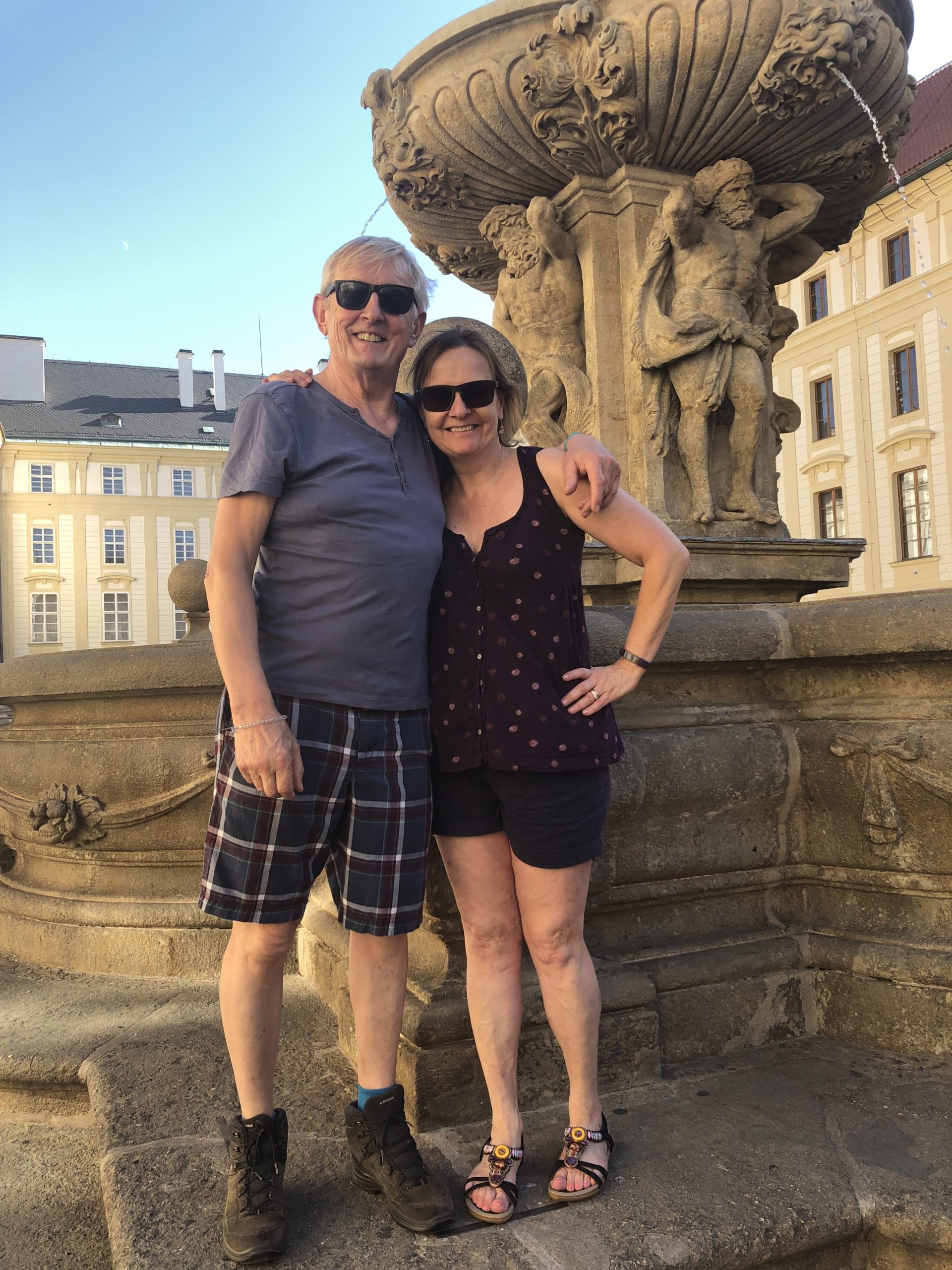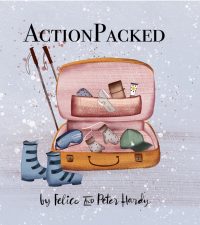
Peter This week, we’re talking to an Australian with an incurable travel bug. Stephanie Hunt has spent the last three decades travelling around the world, skiing, sailing, and her latest exploit: hiking the 2,650-mile length of the west coast of the USA. Stephanie, welcome, to our travel podcast. How did this all come about? You were just 17 when you got hooked on going places.
Stephanie Yes, when I was 17, I was studying at university and working for Pricewaterhouse and took a two-week skiing holiday to New Zealand. It was my first holiday as an independent adult and I joined a group there on a tour of New Zealand ski fields and had such a wonderful time that I arrived back in Australia, gave three weeks’ notice to my employer, quit university, and worked a second job to save a few hundred dollars. And with a backpack, a sleeping bag, 400AU$ and a one-way ticket, I left Australia on my 18th birthday.
Peter And you went to New Zealand?
Stephanie I went back to New Zealand. Initially worked in the ski fields there at Mt Hutt and then went up to Auckland after the ski season was over and did some waitressing there before going to Europe.
Felice Where did you go in Europe?
Stephanie I initially went to Switzerland; I spent a week in Zurich. And then I went to France some of the skiers that I met in New Zealand were working in France. I went to Morzine and Avoriaz and then came home to Australia for a brief holiday. And on my way back to France, a chap that I had met working in the ski school in New Zealand invited me…I had to stop-over in Japan to visit some other girls I’d met previously and one of the chaps from the ski school said to come and visit him there. And I said: ‘I can’t really afford to.’ He said: ‘That’s okay, I’ll get you a job.’
So I tried it off to an area in Nagano, near Hakuba, to see him. And then I said: ‘What’s this job you’ve got me?’ He said: ‘Oh, I got you a job as a ski instructor in the ski school.’ And I said: ‘That’s great, except that I worked in a cafeteria.’ So the couple who owned it – or the guy who owned the ski school – also he ran a ski lodge with his wife. So I cooked and cleaned for them for the rest of the winter season and for the spring and summer as well.
Felice So what’s influenced you to do all this travelling? When you were growing up did you travel a lot with your family?
Stephanie Yes, we did travel a lot. We had never really done much skiing. I’d only ski twice before going skiing in New Zealand. My grandparents had a farm, so we were always heading off to the farm. My dad became a glider instructor when I was about seven and then bought a powered plane. And so we started doing a lot of plane travel and then he had a small charter company, so that opened up some other opportunities for some longer distance travel by small plane, all in Australia.
But we were always heading off somewhere to go waterskiing or motorbike riding. And every year for three weeks, we went to Foster, just a little seaside town a few hours north of Sydney. We went there every Christmas and camped there for three weeks each year from when I was 10 until my late teens.
Peter And so after Japan?
Stephanie While I was in Japan, I went to Hong Kong. My mum flew over to Hong Kong. And while we were there, we spent a few days in China. And I was supposed to go to Indonesia after Hong Kong, but I liked China so much that I cancelled my flight to Indonesia. And when Mum left Hong Kong, I went back to China and spent two months travelling in China and then another month travelling in South Korea. This was in 1987, I think, just before the Tiananmen Square massacre. I recall, you know, a number of friends were concerned about my whereabouts when that happened.
Peter So travel inside China in those days was really quite difficult. And you bought a bike. Is that right?
Stephanie Yes, it was really challenging because only 155 cities in the whole of China were open to tourism at the time. And when I was on the boat going over to Guangzhou, I met a chap and we spent the first week travelling together. And he was there on his bicycle to do some long-distance touring. And that was a little bit out of my experience, but I did see the advantages of having a bike while I was in China. But the area between the towns and cities weren’t actually open to tourism, and being in those areas was an imprisonable offence. So it was a little risky to ride, but also a lot of fun.
Felice Did you ride around Beijing? I once rode around Beijing on a bike – there’s so many bikes, incredible.
Stephanie Yes, there are. And certainly then, people didn’t have cars – only the only government employees had cars. In fact, cars were so rare that the time I was there was when the Chinese government was trying to stimulate the economy. And so they told farmers that they could keep a certain percentage of the yield from their annual production, their annual harvest. And they also provided them with harvesters so that they would transition from using water buffalo in the field.
But because these people didn’t have cars, they kept their water buffalo in the field and they drove their family around from place to place in the harvester on the road. And as you say, in the city, there’d be a few cars at a traffic light, but 500 bikes. I never made it as far as Beijing, though, I spent two months travelling in China and never made it further north than Shanghai.

Bikes in Beijing. Photo: © F.Hardy
Felice And then later on you went back to Australia?
Stephanie I did. So I spent time in China and then went to South Korea. I went back to Japan and taught English there for a while and then went back to Australia.
Felice And then you had a family?
Stephanie I did. I had a son, which was an exciting period in my life. I’d just enrolled in university and so he had the good grace to be born between my first and second semester of university. That was a challenging period, raising a child, working and and studying at the same time.
Felice And then you set off again when he was two, you went travelling with him, is that right?
Stephanie Yes. So I had an opportunity while I was doing my degree to do a semester of study in the UK at the University of Humberside. So I saw that as a great opportunity to go and spend some more time in Europe for a couple of months before I went to Hull. I had friends in Ulm in Germany and they helped me buy a little car – a 1977 Volkswagen Polo, and we put his car seat in the front that looked like a rocket ship. And so my son sat up at the front with me, he was only two, and we drove 20,000 kilometres around Europe and Eastern Europe before I went to England to study.
Peter Whereabouts did you go?
Stephanie We started in Germany and went to Austria, Italy, Greece, Bulgaria, Romania, Hungary, Slovakia, Slovenia, back across through Austria, back into Switzerland. Then through different countries up to Belgium to take the ferry across to the UK, and then had at a great opportunity there to also go to Scotland and Wales while I was studying and spent a week in Ireland as well.
Felice So all of that with a two year old in your car? That must have been tricky sometimes?
Stephanie It was it was tricky sometimes. When it got tricky was at the end of a really long day’s driving. We were usually in some really busy city. We didn’t have a GPS then or all of the tools, the electronic tools that we have now. Driving around, trying to read a map in the dark and find where on earth we were supposed to stay in, that’s when my son would really lose the plot. And so he’s screaming, I’m trying to deal with the traffic. I was driving on the other side of the road. Those evenings were very challenging. And there was more than one occasion where it just got so hard that we ended up driving out of the city. And we had a tent and I’d just find a spot to pitch the tent. We’d just sleep there and deal with it in the morning.
Felice But usually, did you book somewhere to stay or just turn up?
Stephanie Yes. But sometimes you just couldn’t find it.
Peter So after a term at Humberside, you left England again?
Stephanie Yes. I came back to Australia. So my son was two and a half then and spent the next few years buckling down and getting some work done. I finished my degree when I got home and worked for the university for a while and then moved back into business and had a job that became very stressful there for a while.
I was at the gym one morning when a guy that I used to see every morning at the gym, fit and healthy, was always there. He died at the gym when I was there, fell off the back of the bike and couldn’t be resuscitated. Myself and another lady gave him CPR and couldn’t revive him. And I spent the rest of the day just really wondering what was I doing with my life? Why was I staying in this job that had become really stressful? It was a really toxic environment for me.

Swimming The Great Barrier Reef. Photo: © F.Hardy
And so six weeks later I quit my job, bought a yacht, sold my house, and was living on the yacht initially in the marina just for another six weeks while my father helped me transition it for onboard living. And then we set sail and spent two and a half years sailing up and down the Queensland coast, thousands of islands in the Great Barrier Reef.
Peter Did you know about sailing? Had you learnt how to sail as a child?
Stephanie No, I’d never sailed. So at the time that this happened and I had been dating a fellow with a yacht and he’d introduced me to some other people who were also living on board their yacht. And also I went to a barbecue and there was a family – a couple who had two children on board. So it became clear that having a child wasn’t an obstacle to sailing. They were homeschooling their kids. And I looked around and thought, these people aren’t rocket scientists. If they can do it, I can do it.
So those six week that I was in the marina fitting out my boat, I learnt to sail it. And sometimes that was just a case of asking someone else from the marina who had a spare afternoon if they could come and spend a couple of hours with me on my boat and show me how to do something that I didn’t know how to do yet. And the first three days when we left for good, I did ask someone to sail with me who is quite experienced. We had to go over to a bar that had quite a reputation. And so I asked if he would help me sail across the bar. And then he left after three days and we were on our own after that.
Peter That was scary?
Stephanie It was scary and it was exciting. We left at midnight because we wanted to get the tide out of the river, the pull from the river. If the tide was running the other way was quite significant. And at seven o’clock in the morning, just after it had become light and it was the first time both myself and my son had been seasick. It wasn’t particularly rough, there was just a funny roll that upset our stomachs. And I’d gone down below to plot our course, which I did every hour.
There was this almighty crash on the deck. And I went running up and I couldn’t comprehend what I was seeing. The sail was in the water. There was a big beam in the water. And I at first I thought it was the mast; it turned out it was just the boom. And I’m just going like: ‘What’s gone wrong?’ And so my son helped me winch the sail – it was really heavy, it was full of water. Then I got on the highest point of my boat and called my friend who had sailed with me to Bundaberg, and said ‘The boom’s down and the sail’s in the water, what just happened?’ And he said: ‘I think you broke your topping.’
I said ‘What’s that? Is it important?’ So we ended up motoring to Lady Musgrave Island. And while we were there, some people on another yacht helped winch me up the top of the mast. And I just did a temporary measure to fix the sail back up. I couldn’t sail with the sail in full extension. It had to be reefed down in order for us to sail back this way. But then we were able to spend a few days there and sail at leisure until we got to Maokai and had the u-bolt put in back on the top of the mast and a topping repaired. And we were fine after that. It wasn’t our only scary moment, but it was the first one where I’m just going: ‘Oh my God, what am I doing?’
Felice How old was your son at the time?
Stephanie He was nine. It was just the two of us on board. So he was my first mate. They call sailing solo, single-handed sailing. And I felt like sailing with a child sometimes was like sailing with both hands tied behind your back. But he was actually very good and picked things up very quickly and was very sensible and very innovative on board. Sometimes there were situations that I was stumped and he sad: ‘Hey mum, I think you should try this.’ And he was often right.
Peter So where did you go on your yacht?
Stephanie The first year we just sailed from Brisbane up to the Whitsundays and back to Brisbane, we sailed through quite a lot of islands and coastal bays and things like that that aren’t really accessible by car or the island’s uninhabited.
Then the second year, we sailed all the way up to Lizard Island, which is north of Cooktown towards the Torres Strait – not in the Torres Strait. And then we sailed back from there to the Whitsundays – well actually back from there to Dunk Island. And I spent a summer anchored at Dunk Island and doing some diving instruction. And then the next year we just went back and sailed around the Whitsundays.
Felice Wow, sounds amazing. Your next adventure after that was hiking?
Stephanie There’s most certainly my most recent adventure was hiking. In 2018, I hiked the Pacific Crest Trail. It’s in the United States. It runs the entire distance from the Mexican border to Canada. It’s not a coastal trail, although it does parallel the coast – everywhere from 100 to 150 miles inland from the coast. It runs up through the high desert, then through the Sierra Mountains and then through another mountain range called the Cascades. So it goes through California, Oregon and Washington. The entire trial is 2,650 miles or 4,250-odd kilometres. And on average, it takes about 149 or 150 days to complete. It took me 155.
I was doing some work in Perth in 2015, and the same year the movie Wild with Reese Witherspoon came out. And when I was watching that movie, I realised that a woman in a hiking group that I was a member of was hiking that trail at the time. And when she came back, she did a talk and I went along with a friend and was really inspired and thought, you know, I’d really love to do that. And it was just an incredible experience. I was so inspired by my friend’s talk and as soon as I got the opportunity to go, I took it. And off I went.
Felice What was the terrain like?
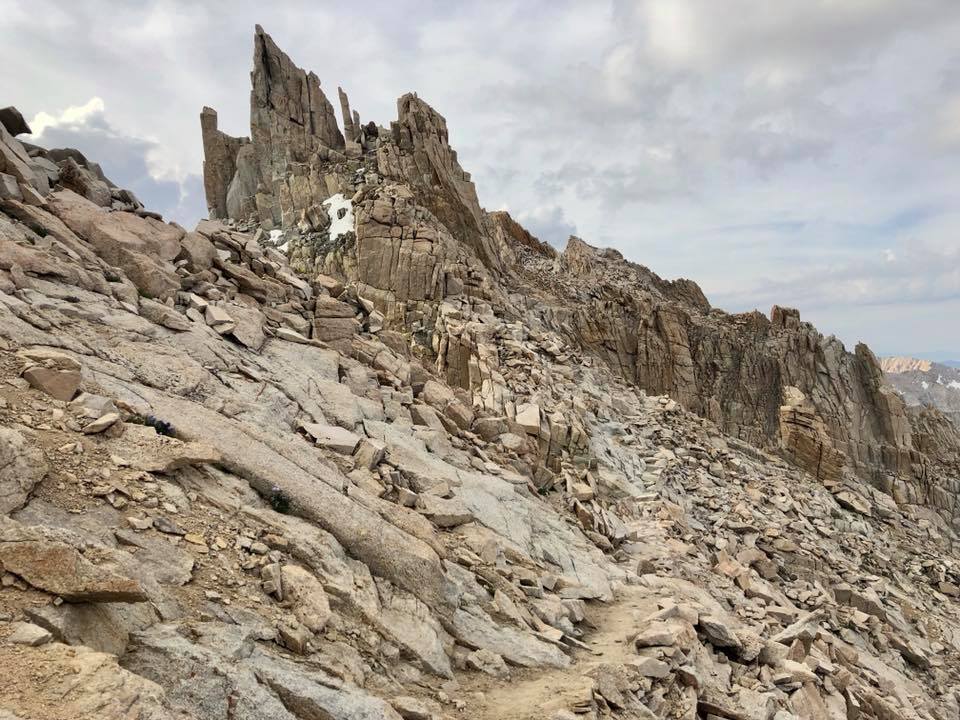
Trail down to Whitney
Stephanie So the first 700 miles…and I have to apologise that I can’t tell you these distances in metric, because as soon as I got over there, I realised that if I didn’t start thinking about everything in the way that the local people thought about, in the way the signage was and things like that, that I’d be forever converting and I would make mistakes.
So the desert section goes to 700 miles, and it’s…I was going to say…relatively flat. I mean, there are still mountain ranges, and you’re still hiking up into areas of snow and back down into valleys. It’s called the Pacific Crest Trail because it follows mountain ranges. So it’s certainly not flat by an Australian definition of flat, but it’s comparatively flat until you get into the Sierra. And then you are just climbing up 6,000 feet a day, down 6,000 feet a day. The entire distance is like climbing from, or hiking from, the sea to the top of Everest back to the sea, 17 times the distance and the elevation. Gain and loss is similar.
Felice Wow, that’s amazing. What about the weather? Was that okay or was it sometimes too difficult to hike because of the weather?
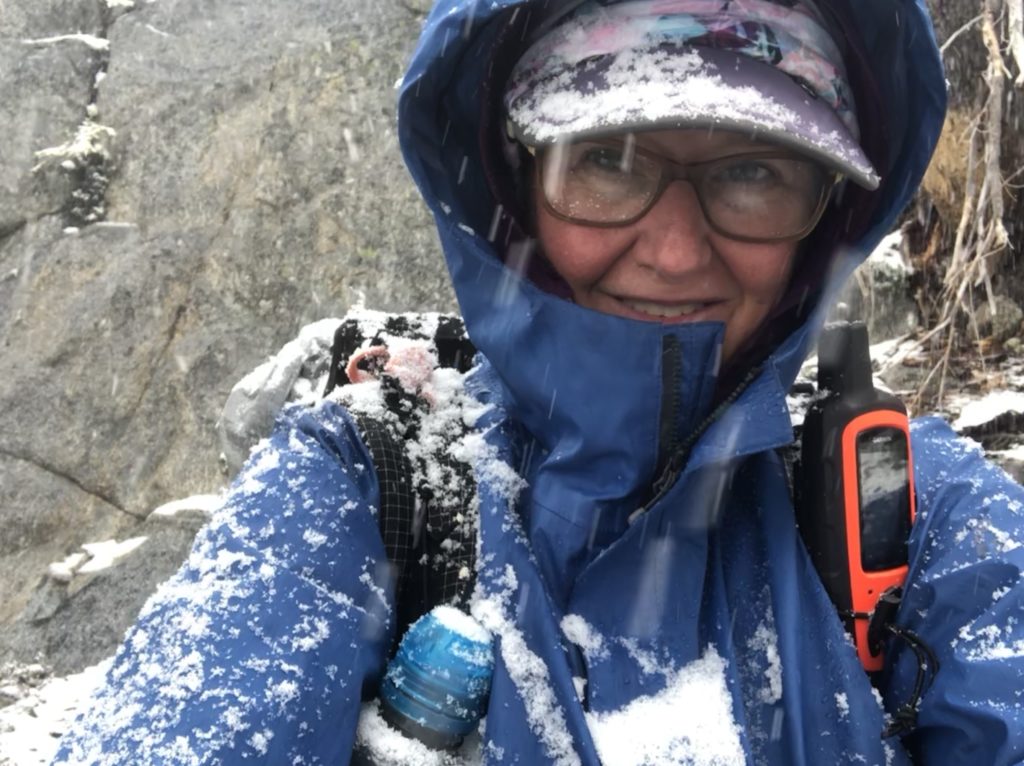
Summer snowstorm in the Russian Wilderness, northern California
Stephanie I had more rain than most people usually experience, which wasn’t a bad thing. It made the desert cooler. I started early by traditional start dates for the Pacific Crest Trail. And that meant that I arrived at the Sierra early, even though the conditions were possible for people to go in there. Because I’m from Australia, I have never really spent a lot of time in the snow fields; I don’t have a lot of experience with snow and ice. And I made a decision that it wasn’t right for me to go in at that time. So initially I took two weeks off the trail and went to see the Grand Canyon and a number of other places in the US that I was really excited to visit like Zion and Brice National Park.
I was watching the accounts of other people who were hiking into the Sierra at the time, and they just sounded pretty miserable to me. They were post-holing from nine o’clock in the morning. Usually you have a fairly solid snow until midday, so you can start at four o’clock in the morning, hike to midday, and then your day is done. Well they were starting at two and hiking to nine, and then sometimes post-holing up to their waists. And I thought, this doesn’t sound like very much fun.
I went north to skip the Sierra altogether and went back and did it later. But I skipped north to an area, funnily enough, called Sierra City and started hiking north from there. I still encountered snow and I definitely felt out of my depth and it was now hiking alone. I went as a solo hiker, but you meet other people and there are always other people travelling in the same direction as you, hiking it a fairly similar paces you. And so you run into them all the time – throughout the course of the day, you might be in the same campsite, you might have chosen the same place to camp at night. Well, there was no one. I didn’t see anyone for six days, five and a half days. I was worried that I was too slow.
I didn’t see anyone. I needed to just stop and sort of take measure because it was taking me a lot longer to hike this section than I thought, because of the snow. And I was worried that I might run out of food. And then I realised when I sort of did a bit of an assessment of where I was at, that it wasn’t food that was the problem because I couldn’t see the trail, because I couldn’t see many footprints. I was using my phone as a GPS a lot to find the trail, so then I was concerned that I didn’t have enough power in my battery pack to keep my phone charged for the length of time I was going to need to get to the next town.
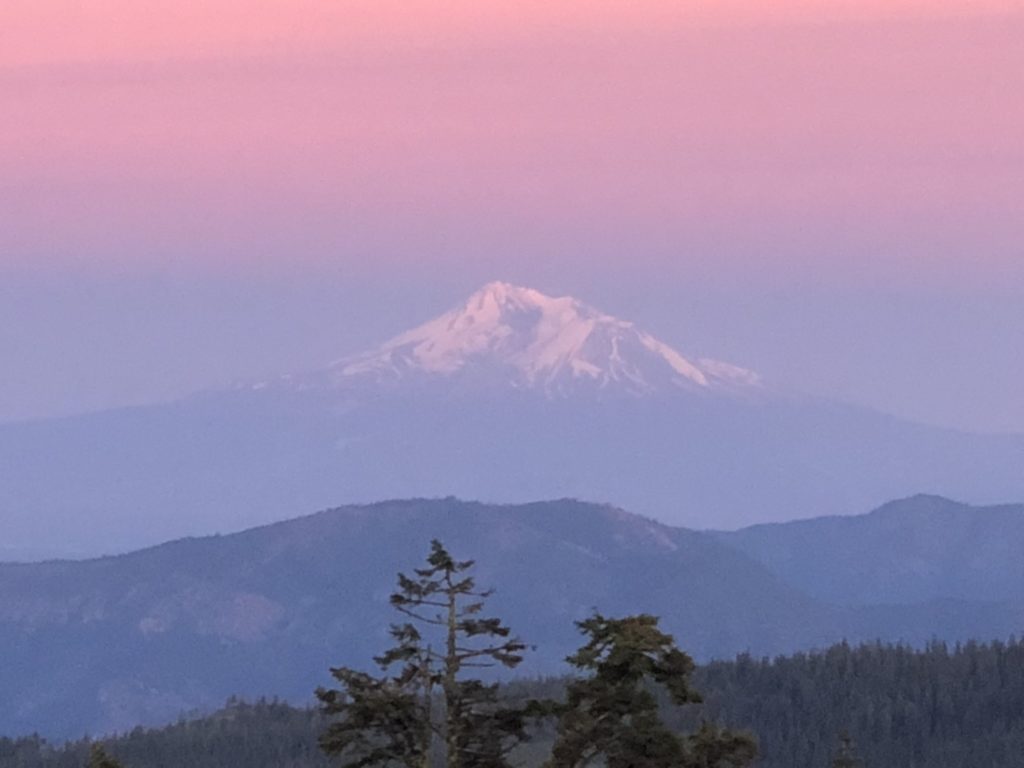
Mt Shasta sunset glow
I decided that I could afford to continue for half a day longer until the end of that day. And if the conditions didn’t improve, then I needed to go back. And I had met previously people who had come back out because they were finding the conditions too tough. Anyway, I got to the end of that day and things were much better. There was a lot less snow, so I continued. That was probably…it wasn’t bad weather, just conditions that were out of my depth. I had a couple of slips in the ice, and one of them – I nearly thought I was going to land in a lake that I might have had trouble getting out of. And so I had to, you know, take these things into consideration. But other than that, I think I was pretty fortunate with the weather, through a few thunderstorms and hiking at 6,000ft, 8,000ft through a lightning storm is really scary.
Felice Sounds it, yeah.
Peter Where did you sleep? You obviously had a tent with you?
Stephanie You carry a tent with you and you just find a bare patch of dirt on the side of the trial. There’s an app, or a couple of apps, that you can follow that tell you where there might be places like that coming up. At the start of the day or the night before, you might look at what you want to accomplish for the next day and choose something that you think is a suitable distance. Occasionally you pass something else as you’re getting sort of close to the time of day that you’d like to finish and you think: ‘This looks nice,’ or you might push on a little further. I didn’t use my tent a lot, though. I often slept without my tent just on the ground with my sleeping bag, and that’s called cowboy camping. And one time I went a whole month without sleeping in my tent. Cowboy camping was my preferred way to sleep if it wasn’t going to rain during the night.

Cowboy camping with Mt Shasta background
Felice What about wildlife? Was there anything like bears or anything that could have been dangerous? Snakes?
Stephanie Yes. These three states have rattlesnakes and other snakes, but most of the other snakes aren’t venomous. Rattlesnakes, bears and mountain lions. So I like wildlife, I was excited to have wildlife encounters like those. So I‘m quite accustomed to hiking where there are snakes in Australia, even though I saw some rattlesnakes, they were experiences that excited me and, oh my God, I was so excited the first time I saw a bear, I was absolutely thrilled. I’d had my eyes peeled because some other people I’d passed going the other way said that they’d seen bears and it was just such a highlight. And I had run into someone, was hiking with someone at that stage and they said: ‘Oh, you’re hiking much faster now. Is it because of the bear?’ And I said: ‘Not because I’m scared of the bear,’ just that I was so excited. I was on cloud nine. I saw seven bears on the trail and I was delighted with every bear experience. I never saw a mountain lion; I would have loved to have seen a mountain lion.
Felice Was there any danger from the bears, or did you know what to do to avoid that?
Stephanie Oh, these are black bears, which are not the same as grizzly bears, they don’t have the same reputation as grizzly bears. You do have to be sensible. It’s important that you don’t get between a mother bear and her cubs. And it’s also important that you take adequate care of your food and particularly how you store your food at night. So through the Sierra, you must use a bear can and you should put your bear can away from where you camp at night. And there were other areas where that was sensible as well. I often slept with my food, though – with the bear can.
Felice What is a ‘bear can’ exactly?
Stephanie It’s a canister that fits all of your food and all of your toiletries and all of your rubbish. And so they’re all the scented things that a bear might decide that it likes the smell of. And it’s got special anti-lock pouches. If you think about childproof locks on, say, medicine bottles, it’s like that only 50 times bigger. And the lock is much harder, you usually need a tool to help you open the lock because the bears are very clever and learn how to open these devices. You store it away from your tent, but you don’t store it near a cliff because they will drop them over the cliff to smash them open that way. I didn’t have any trouble, but I did encounter some other people who had all their food eaten by a bear.
Felice What did you do about water?
Stephanie So fortunately there’s a water report that tells you any areas where water is scarce, which is the desert, and one or two other sections. It tells you where you can expect water and people update it as they travel along. I also mentioned that there was an app that you could use as a GPS and you could also look at the reports for water there. So when I found water in sections where people weren’t sure if there was water, there was an area where I was hiking through. And so I would always update to say where I found water. They’re the two big considerations each day: where is the water and to make sure that you carry enough, and where will you camp?
Peter Tell us about the people you met along the way?
Stephanie The people I met were amazing. You were told before you go by people who’ve done it before that you will make the most incredible friendships, and you’re expecting it. But there’s just something…I don’t know if it’s just this trial or if it’s embarking on a long-distance trial, but there’s something that just cracks your heart wide open and you approach these friendships in just a really genuine way.

Tramily and rescuers on Mt San Jacinto
You make friends with people that you probably wouldn’t encounter in your daily life, you know, that are very different to you, live very different lives, a range of ages and lifestyles and countries. And I just fell in love with everyone. It was an incredible experience. I was very lucky early on to develop a trail family, which is called a Tramily, and you were given a trial name, usually on a long-distance trail most people were given a trail name. And the young guys who I fell in hiking with on day 48, 49, then I sort of fell in with these also solo travellers. A group of guys, mostly in the mid 20s, a range from 20 to 30 and a couple older. And they gave me the trail name Wendy of the Lost Boys. They thought they were Lost Boys from Peter Pan and so my trail name became Wendy of the Lost Boys. And from then on, I was not known as Stephanie anymore but as Wendy. The people you meet, it really is an amazing experience and you do form very, very strong bonds. You know when you run into the same people in different places and you get really excited that you’ve met them before? Well, this is very much more intense than that – to try and give you an example of what it feels like.
Peter You mentioned trail angels. What are they?
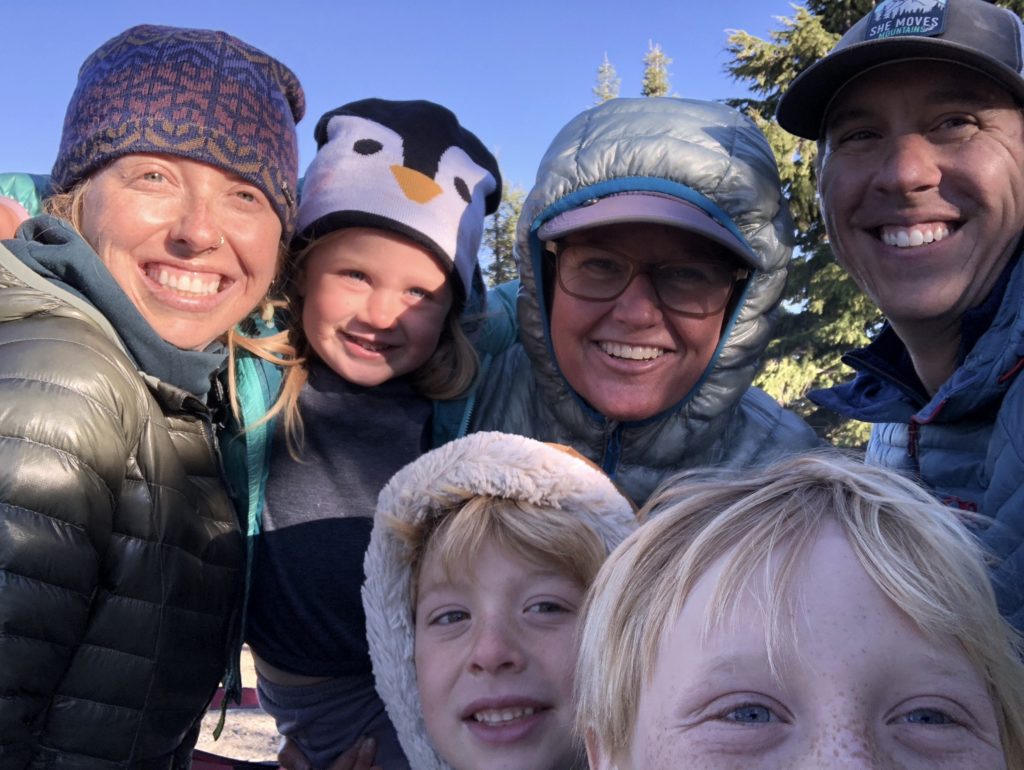
Kominskey Family – trail angels
Stephanie So trail angels – the trails wouldn’t be the same without them. They’re really special people who usually aren’t hiking, but they provide services to hikers. So I was part of a Facebook group and a woman who is a trail angel offered, when I arrived in America, for me to stay at her house and then she would take me to the trail. So she picked me up from San Diego and drove me to her house. I stayed there for a couple of days while I got over my jetlag, did my first resupply. It’s quite difficult for international travellers because you can’t bring your food or any food really with you, so you need to do your first shop. Usually Australians want to get some gear over there as well because it’s less expensive than in Australia. And so I stayed with her for a couple of days and then she drove me to the start of the trial and then trail.
And then trail angels from then on, are people who offer you somewhere to stay while you’re in town, might offer to help drive you somewhere if you need something special during resupply. They also just do random pop-ups on the trail where someone will park somewhere and open the boot of their car full of food and cold drinks. Trail angels come in all different forms and provide an amazing service, usually at no cost to hikers. I’ve never experienced such incredible generosity.
Felice What did you take with you on the trail in your pack?
Stephanie Mostly on a long-distance hike like this, you’re aiming to have your pack as light as possible so you don’t take anything that you’re not going to use. And nearly everything needs to have a multi-use purpose. So my big four: my pack, my tent, my sleeping bag and my mat. Then I had hiked without a stove, so I had cold food the whole way. So the only thing I really had in my food bag was a spoon and a little knife. Then I had bear clothes. So hikers don’t carry a lot of clothing with them – you’ve got the clothes you’re wearing that you hike in. Then you’ve got warm clothes you put on if you need to. So I hiked in shorts and a fishing shirt, which I found was really vented and had quite good airflow. And then I had a puffy to put on if I got cold, and I had a rain jacket and rain pants. I ended up dropping the rain pants from my kit.
And then you have the clothes you sleep in, which really is just a pair of thermal tights and a thermal top. And you can layer them with your hiking clothes if conditions get really cold. So you sleep in your thermal gear with your puffy. And I had a quilt, not a sleeping bag, and that’s a little bit lighter. And it works on the basis that when you’re lying on down, you’re compressing it and it’s not insulating you anyway. Other than that I had a very small first aid kit, a couple of toiletries, but really just toothbrush, toothpaste and toenail clippers. And then I had electronics and navigation and spares and repairs. So a compass, battery pack, my phone. My entire pack weight, without food and water was around seven kilos. Food generally was sort of 500 or 600 grams a day of food, and I rarely had to carry more than three litres of water on the trail.
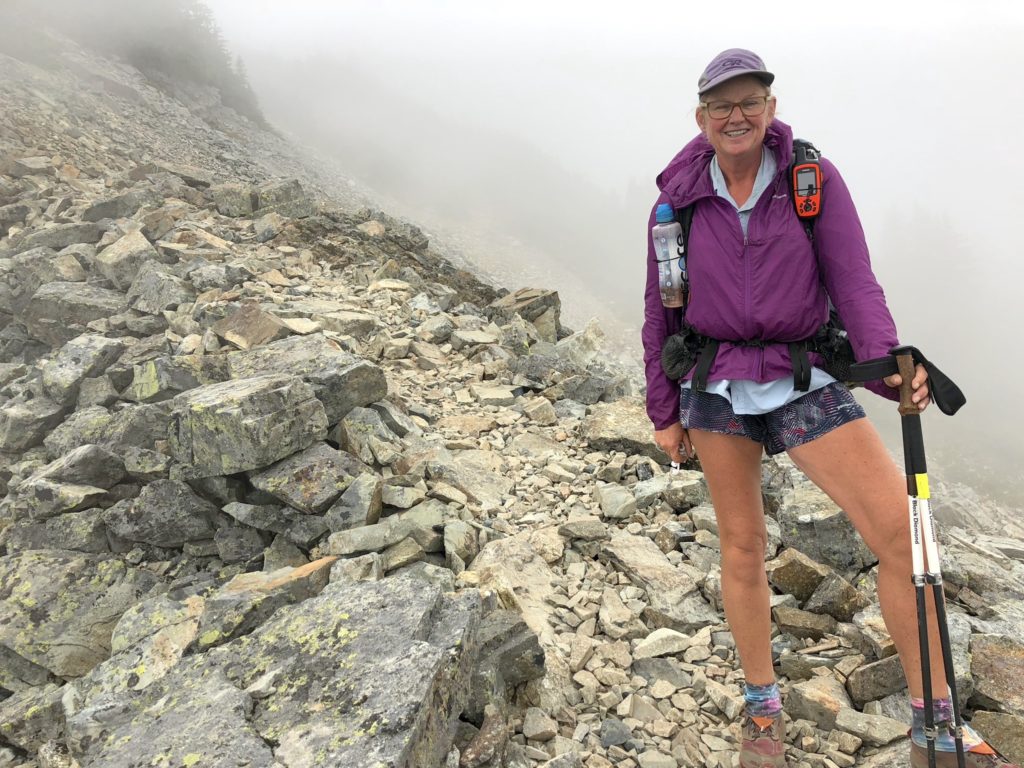
Washington fog
Felice Were there any times when you thought you might not make it, that you might have to give up?
Stephanie Yes. So I had really bad plantar fasciitis when I started, before I started hiking the trail in fact. When I was flying over and even in the car on the way to the trail, I was thinking I might not even last a week. It’s the connective tissue between the ball of your foot and your heel, and it affects different people, different ways. Most people who have it, it’s a little bit painful for them to walk first thing in the morning and then it goes away.
For me, it was like every step was like someone was driving a knife up through my heel. I really wasn’t sure if I was going to be able to complete the hike, but I’d done so much preparation, including moving out of the house where I was living and temporarily rehoming my dogs, and taking six months off work, that I thought I was going to give it a go anyway. I made it through with ibuprofen, but there were times where the pain was quite bad.
Other than that, the section of the trial where I was alone for six days, I really questioned then what I was doing. I felt like I’d already had an amazing experience. I was sad that my tramily were no longer on trail. They left the trial for different reasons. I thought, you know, I’ve got three and a half more months off work, maybe I should spend some of that on a beach in Thailand? Drinking Mai Tais on the beach in Thailand. And so I went through a period like that where it was hard and there were one or two other times where I felt like quitting.
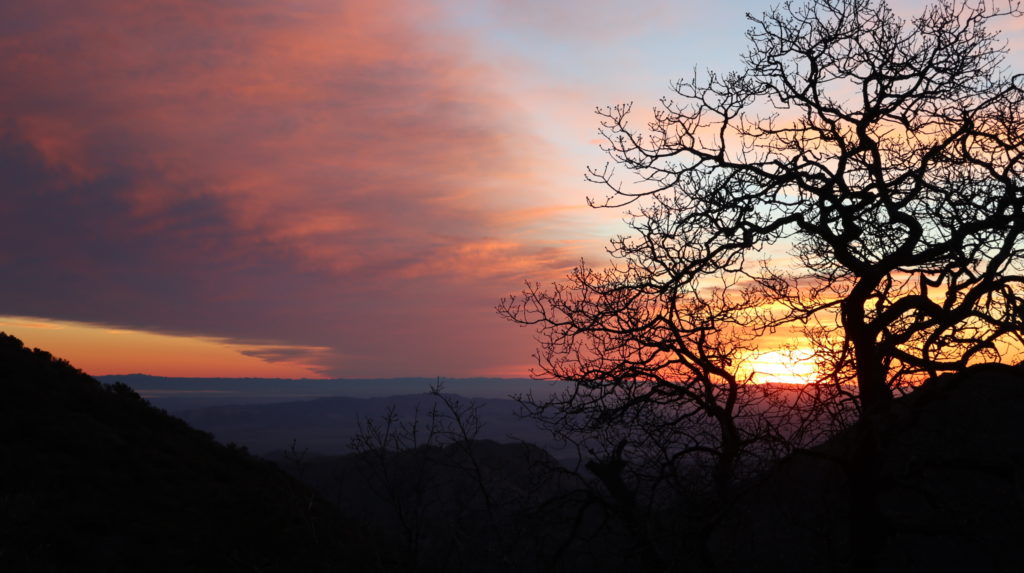
Sunrise on Mt Laguna
One of the things that kept me going, because I had initially skipped the Sierra because of the snow, I hiked through Northern California and hiked through all of Oregon. And the thing that kept me going was you haven’t seen the Sierra yet and you haven’t seen Washington yet, which are the two most spectacularly scenic parts of the trial. And then I got into the Sierra and I just didn’t have the connection to it. As I was hiking, I thought: ‘You know, I think I’m done. I think I’ve seen everything I wanted to see.’ They say don’t quit on a bad day – that’s the advice from other hikers. Never quit on a bad day because usually there’s better times ahead. And this wasn’t a bad day.
The day that I made the decision to quit the trail was a really spectacular day. I stopped and had a nice swim in, you know, a really cold river at the base of a waterfall. And then I went and had a nap under some trees in the sun and I thought, yeah, I’m done. And then I looked at the map to see where I needed to leave the trial to end my hike. And there was a junction where I could leave the trail just three miles away. And I thought, that’s a bit close, maybe I’ll take the next one? And I thought, I’m almost at Yosemite, I might as well just hike to Yosemite. I really, really wanted to go there, and that was only a few days away. I thought, well, there’ll be a nice way to finish – I’ll hike for four more days and go to Yosemite and then I’ll be done.
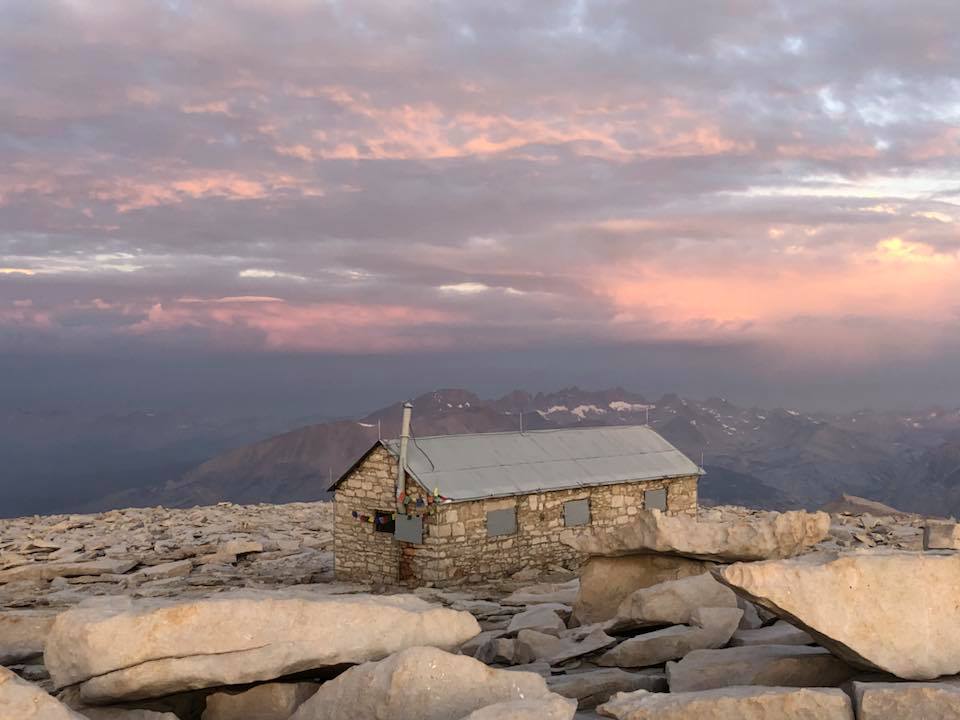
Whitney hut
And as I was leaving there, I played a podcast, a Joe Rogan podcast with a freak of nature called David Goggin. And he just talked about doing the hard things and sucking it up and not quitting. I got to the end of the podcast and I was done with wanting to quit, and I continued and completed the rest of the trail.
Peter Tell us about your journey’s end. Is there a specific point where you run out of trail?
Stephanie Yes. So there is a monument on the Canadian border and you’ve got two options when you reach it. You can then hike 35 miles back into the USA and then try and get to Seattle from there. Or you can hike eight more miles forward into Canada and finish. The night before, I met a woman, just those last couple of days. And we were sort of hiking together, we’d see each other during the day and we’d end up in the same campsite at night. I had a chat to her the night before and we agreed that we both wanted to hike separately in the morning so that we experienced the finish on our own just to really get the full maximum emotional benefit from it. I was expecting it to be really emotional and I was really surprised when it wasn’t. I just sort of got there and went: ‘Yes, there’s the monument.’
It was my birthday, though. So the monument is a quite an interesting shape, these wooden pillars of different heights. And knowing that I was going to finish on my birthday, I’d bought all these Snickers bars and they have different sizes – so I’d like to have twin packs and two packs and single ones and they’re all different sizes and I made myself a Snickers bar birthday cake from all these different-height Snickers bars that look just like the monument.
So I got that out and there were a few other people who arrived just before me and just after me, and we all celebrated together. And it was exciting, but it didn’t have quite the climactic…I don’t know if I was expecting trumpets and things. I thought I’d cry and I didn’t. But it was still incredible. Then those eight miles into Canada, the longest eight miles of the whole trail. It’s over. And you want it to be over, but you don’t want it to be over because really you want to keep doing it forever.
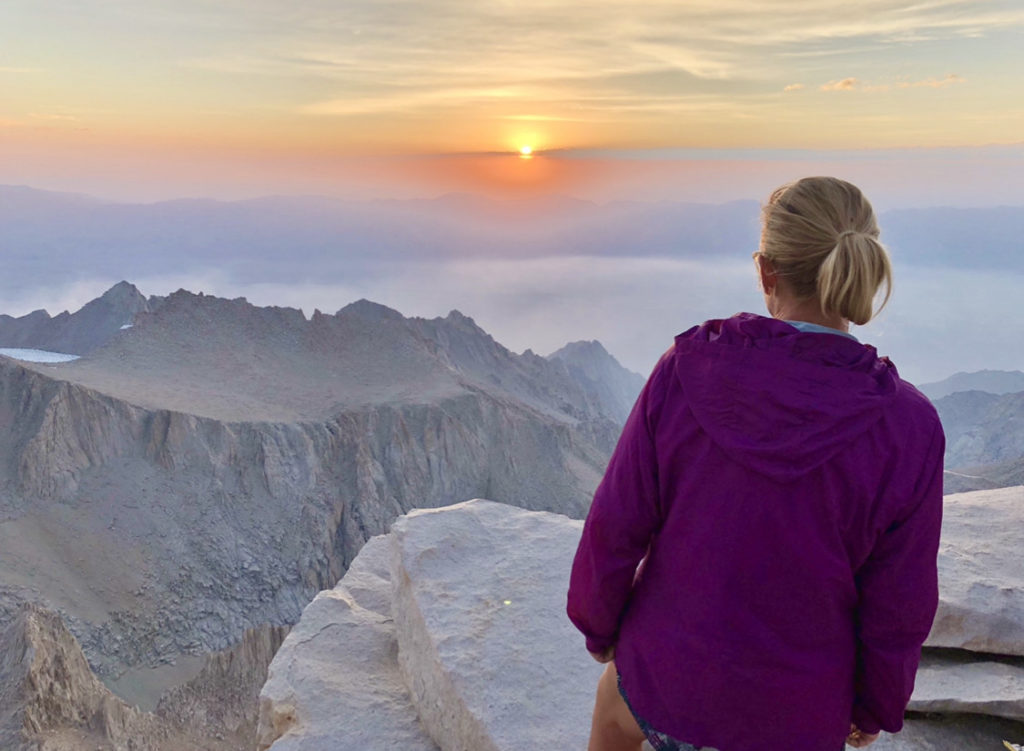
From the summit of Mt Whitney, the highest mountain in the Lower 48
Felice And afterwards, how do you get back to normal life? Was that easy or difficult?
Stephanie It was easy and difficult. If that makes sense. I was back at work a week after finishing the trail, and that was a culture shock in its own way. In that respect, it was like I’d never gone. On the other hand, you’re fundamentally changed, and it’s really hard to work out how you can be that new person back in your old life. And I think for people who go on to create a different life for themselves when they return, I know everyone struggles with it in their own way. But I feel like in some ways that might give you an opportunity to be more of the new person that you’ve become.
One of the things that you really struggle with is you have just achieved this most incredible epic thing. For me, it was incredible and epic and the greatest achievement of my life other than raising my child. And so it’s weird that people don’t know this about you. And it’s not you want to brag about it, but you feel like it’s so significant everyone should just know – that sounds really egocentric I know. It’s hard to explain what I mean by that, but it’s just weird that life is so normal and you’re so fundamentally different.
Peter Now, I know that you’re about to start your own podcast, but how else can people follow your global exploits?
Stephanie Well, I have a Facebook community called Wildly Inspiring Community, which anyone who’s interested in nature-based adventure is welcome to join. They can find that by searching for Wildly Inspiring Community on Facebook.
Peter Stephanie, thank you very much for appearing on our travel podcast. And we wish you the very best of luck in the future with your travels around the world.
Stephanie Thank you so much. It’s it’s been a privilege.
Felice That’s all for now. If you’ve enjoyed the show, please share this episode with at least one other person! Do also subscribe on Spotify, i-Tunes, Stitcher, or any of the many podcast providers – where you can give us a rating. You can also find us on Instagram, Facebook and Twitter. Stay safe and we’ll see you next week.
© ActionPacked Travel
For other action women, see (or listen) to our episodes on Matilda Temperley: Action Woman Behind the Lens, Saving Elephants and Climbing Everest and Action Woman at Action Packed Travel.

- Join over a hundred thousand podcasters already using Buzzsprout to get their message out to the world.
- Following the link lets Buzzsprout know we sent you, gets you a $20 Amazon gift card if you sign up for a paid plan, and helps support our show.


